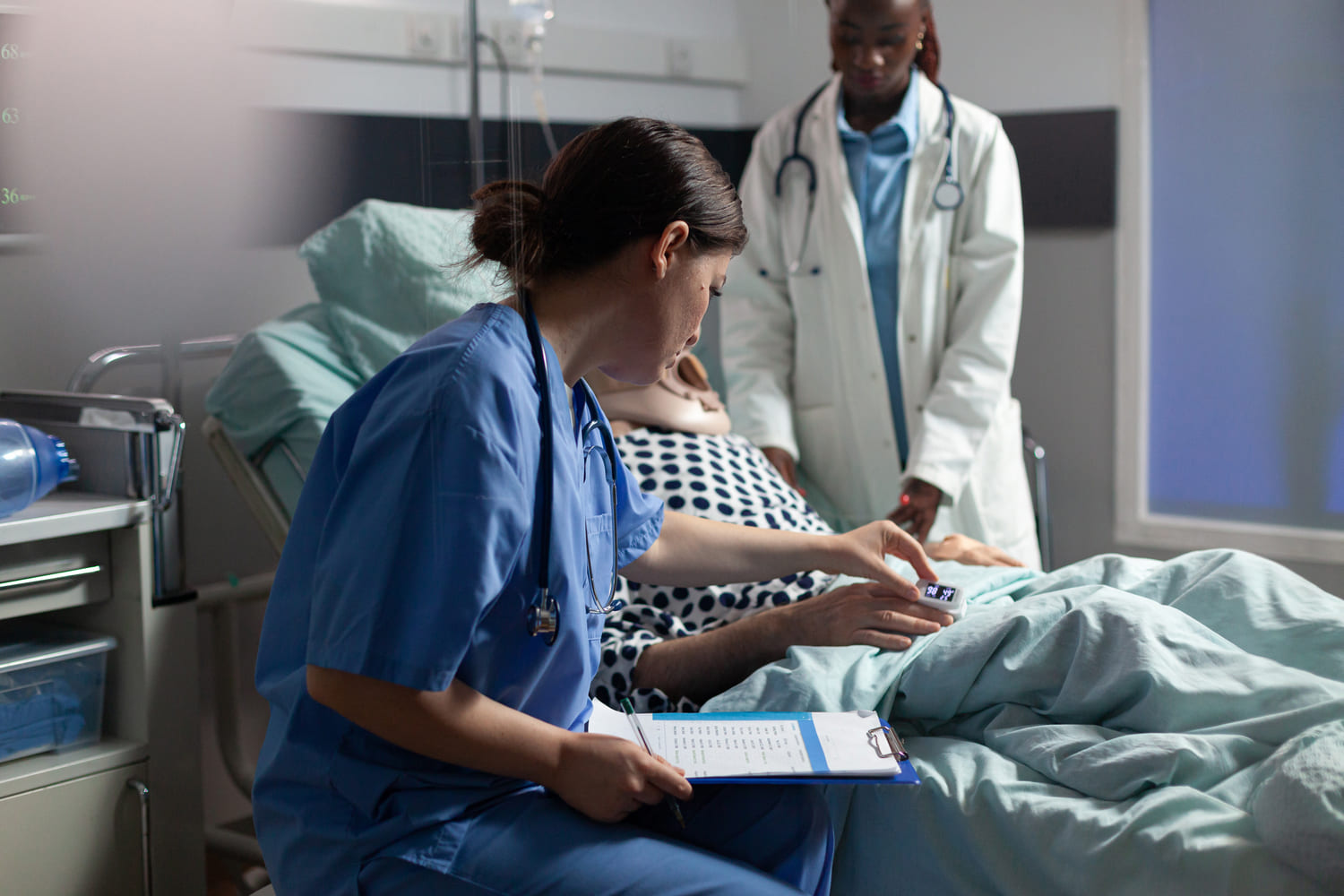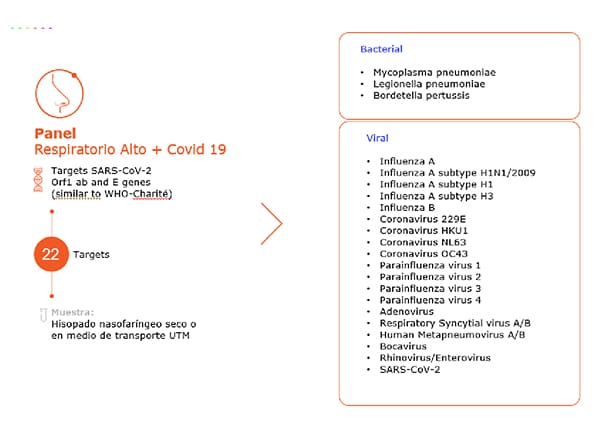Syndromic Dx: Efficient outcomes for proper patient management
Thursday 1 February 2024

Syndromic Dx: Efficient outcomes for proper patient management
Advances in PCR have led to the development of a wide variety of highly specific probes that have enabled the development of “syndromic diagnosis” in severe infections. This approach allows the detection of a large number of pathogens associated with an infectious syndrome in a single test, which provides rapid and highly reliable results that will support medical decisions about patient management and the appropriate treatment to be provided.
One of the advantages of “syndromic diagnosis” is to perform co-detections with high sensitivity and specificity at the same time and in an agile manner, thus reducing the use of second tests and TAT, which contributes to making the right decisions regarding the most appropriate treatment for the patient, in which, as well as the appropriate choice of the antimicrobial, it is also essential to correctly choose its duration, dose and route of administration, which improves the effectiveness of treatment and reduces adverse effects, such as the generation of resistances. (1)

Leveraging its extensive track record in molecular detection, Qiagen has developed an advanced syndromic diagnostic technology, which is automated and provides results for up to 24 pathogens from one sample in approximately 1 hour. The added value of these detections lies in the fact that the results report not only shows whether the sample was positive, negative or invalid, but also provides access to the amplification curves, allowing the conscious validation of all results and the analysis of those that are invalid or show low microbial load.
The Ct values, which represent the number of amplification cycles necessary for the target nucleic acid to begin to be detected, can also be displayed. Thus, these values are inversely related to the number of copies of the target gene in a sample, being lower when there is a higher pathogen load.

For this reason, knowledge of the Ct value has potential clinical utility, as it provides clinicians with information on genomic load and helps guide clinical decisions in infection control, for example, in differentiating between infectious causative pathogens and asymptomatic carrier/colonization. (2)
These are excellent advantages of the two panels developed by Qiagen for the diagnosis of serious infections, which include the respiratory panel plus SARSCoV2, which performs the detection of 22 targets from nasopharyngeal swabs in viral transport medium, and the gastrointestinal (GI) panel, which allows the detection of 24 pathogens from liquid stool suspended in Cary Blair. Both cases include the most clinically relevant viruses, bacteria and parasites in each of the syndromes.

The detection of coinfections may present limitations with traditional diagnostic tests, since they do not include a large number of microorganisms, which allow several of them to be ruled out or confirmed in a single procedure, and which obliges to carry out several tests, according to the evolution of the patient, thus delaying the microbiological diagnosis and therefore the appropriate treatment to avoid complications and sequelae.
Eight studies reported viral co-infections with SARS COV 2, with rhinovirus/ enterovirus and influenza A being the most common co-pathogens. (3). As well, Another study by Kim et all revealed that in 26.1%, other microorganisms were also identified, the most frequent being rhinoviruses and enteroviruses 6.9%, RSV 5.2% and other coronaviruses 4.3%. (4). Accordingly, co-detection of respiratory pathogens such as SARS VOC 2 is important, as it allows the implementation of appropriate infection control measures and possible promising antiviral therapy to reduce possible complications and mortality in patients.
When COVID-19 occurs simultaneously with influenza, it suppresses the host immune system, which may worsen the prognosis of the disease. If the Ct value is known, the viral load of each of the pathogens can be established and it is possible to determine which of these is causing the symptoms at the moment, which can achieve a better direction in the treatment, since, as Vargas K. et all points out, depending on the stage of infection in a patient, it can be decided whether or not to receive antiviral treatment for influenza, since clinical benefit has been demonstrated only when antivirals are started within 2 days after the onset of symptoms. (5)
Likewise, knowledge of the Ct values in severe infections, such as infection by C. difficilemay be a predictor of symptom severity, as well as of increased mortality rate (6)The use of antimicrobial agents, which can direct medical behaviors and support the choice of the antimicrobial, as well as its route of administration and dosage.
On the other hand, Ct values may also be useful in defining symptomatic causality. In a co-detection for this microorganism and a virus, if the Ct value is late for C. difficile, this may indicate that it is not the causative agent of the current symptomatology, but is presenting as a co-infection. For this, it is critical to consider Ct values in the context of clinical presentation and correlation.

It has also been shown that in symptomatic cases of Norovirus and rotavirus infections there is a significantly lower median of Ct values than in patients without symptoms. In the case of norovirus, the differentiation made by the panel between GI and GII subtypes is very useful, taking into account that the severity of symptoms increases in the case of GII and therefore a different management of the infection may be required. Likewise, when comparing Ct values, GII infections had earlier mean Ct values compared to non-GII infections. (7)
Annar Health Technologies is pleased to be part of this solution where in an efficient way better results are achieved, impacting on the reduction of hospital costs that is reflected in the decrease in bed rotation, time in ICU, hospital stay, readmissions due to therapeutic failure and effective isolations, which leads to a transformation in the diagnosis.
For further information, please contact your commercial advisor or send an e-mail request to Yohana.martinez@annardx.com,alexandra.larrotta@annardx.com, Liliana.mora@annardx.com.
REFERENCES
- Barlam TF, Cosgrove SE, Abbo LM, MacDougall C, Schuetz AN, Septimus EJ, Srinivasan A, Dellit TH, Falck-Ytter YT, Fishman NO, Hamilton CW, Jenkins TC, Lipsett PA, Malani PN, May LS, Moran GJ, Neuhauser MM, Newland JG, Ohl CA, Samore MH, Seo SK, Trivedi KK. Implementing an Antibiotic Stewardship Program: Guidelines by the Infectious Diseases Society of America and the Society for Healthcare Epidemiology of America. Clin Infect Dis. 2016 May 15;62(10):e51-77. doi: 10.1093/cid/ciw118. Epub 2016 Apr 13. PMID: 27080992; PMCID: PMC5006285.
- Bonacorsi S, Visseaux B, Bouzid D, Pareja J, Rao SN, Manissero D, Hansen G and Vila J (2021) Systematic Review on the Correlation of Quantitative PCR Cycle Threshold Values of Gastrointestinal Pathogens With Patient Clinical Presentation and Outcomes. Front. Med. 8:711809. doi: 10.3389/fmed.2021.711809
- Lai, CC, Wang, CY y Hsueh, PR (2020). Co-infecciones entre pacientes con COVID-19: ¿La necesidad de una terapia combinada con agentes no anti-SARS-CoV-2 ?. Revista de microbiología, inmunología e infección = Wei mian yu gan ran za zhi , 53 (4), 505–512. https://doi.org/10.1016/j.jmii.2020.05.013
- Orozco-Hernández, Juan Pablo, Montoya-Martínez, Juan José, Pacheco-Gallego, Manuel Conrado, Céspedes-Roncancio, Mauricio, & Porras-Hurtado, Gloria Liliana. (2020). Coinfección por SARS-CoV-2 y rinovirus-enterovirus en una paciente adulta joven críticamente enferma en Colombia. Biomédica, 40(Suppl. 2), 34-43. Epub November 12, 2020.https://doi.org/10.7705/biomedica.5516
- Vargas-Ponce, Kenneth G., Salas-López, Juan A., Llanos-Tejada, Félix K., & Morales-Avalos, Antonio. (2020). Coinfección de COVID-19 e influenza: Reporte de cinco casos en un hospital peruano. Revista de la Facultad de Medicina Humana, 20(4), 738-742. https://dx.doi.org/10.25176/rfmh.v20i4.3158
- Bonacorsi S, Visseaux B, Bouzid D, Pareja J, Rao SN, Manissero D, Hansen G and Vila J (2021) Systematic Review on the Correlation of Quantitative PCR Cycle Threshold Values of Gastrointestinal Pathogens With Patient Clinical Presentation and Outcomes. Front. Med. 8:711809. doi: 10.3389/fmed.2021.711809
- Zaid Haddadin, Einas Batarseh, Lubna Hamdan, Laura S Stewart, Bhinnata Piya, Herdi Rahman, Andrew J Spieker, James Chappell, Mary E Wikswo, John R Dunn, Daniel C Payne, Jan Vinjé, Aron J Hall, Natasha Halasa, Characteristics of GII.4 Norovirus Versus Other Genotypes in Sporadic Pediatric Infections in Davidson County, Tennessee, USA, Clinical Infectious Diseases, Volume 73, Issue 7, 1 October 2021, Pages e1525-e1531, https://doi.org/10.1093/cid/ciaa1001



